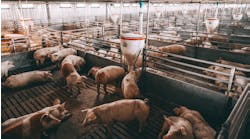This wouldn’t seem to be the best of times for the food and beverage industry.
Companies are struggling with labor and supply chain issues, to the point where they’re having trouble filling orders. Inflation is raging to an extent unseen in decades, driving up both the cost of the supplies companies need and the prices they must charge for their own products.
The labor situation looks especially bad. I’ve been covering the food industry for going on 30 years, and strikes were virtually unknown in that time. This year three of the biggest food companies in the country dealt with strikes; one of them, against Kellogg, was still unresolved at press time.
Being a sourpuss in general, I am normally quite willing to go along with pessimism. But I’m going to venture into Pollyanna cosplay and say that for the foreseeable future, things are looking up for the industry.
I got that impression after a trio of recent trade shows, the first ones I had attended since the pandemic lockdown. I was struck by how many of the exhibitors I talked to, regardless of what floor traffic was like at the time, raved about the quality of their leads. Apparently, this is no time for looky-loos; people don’t take the trouble to travel to a trade show any more unless they’re ready to buy something.
Even more striking than the presence of ready buyers was the absence of machines for them to look at.
Time and again, when I asked equipment suppliers to show me their hot new models, I heard, “Oh, we had to ship everything we had on hand.” Some exhibitors had machines on the floor sporting “Sold to...” signs. Others had to show videos of their new equipment instead of the real thing. “I can’t make a customer wait so I can show something here,” one exhibitor told me.
Equipment of all kinds, in other words, is flying out the door. A good year in the past might see a 6% increase in sales for packaging and processing machinery, according to PMMI, the Assn. for Packaging and Processing Technologies; in 2020, the increase was 14.4%, to $12.3 billion. Demand is so intense that at the time of PMMI's Pack Expo in late September, there was a backlog of equipment, ordered but not yet delivered, that reached $3.14 billion.
As usual with the supply chain, the problems are labor and materials. OEMs are having the same challenges as everyone else finding labor, especially the skilled kind they need. And stainless steel, that industrial building block, is in huge demand for all kinds of applications; its price is up almost 17% for the first six months of this year, compared to last.
Those problems have their counterparts throughout the supply chain. Processors can’t get the raw materials they need, due to high demand and, in many cases, drought or other adverse growing conditions. They also are having trouble finding labor, as are the distributors, grocery stores and other trade customers they sell to.
This may very well seem perverse to people who are struggling with these issues, but from a collective standpoint, these are good problems to have. They’re good because they stem to a great extent from the same situation: sudden or incipient prosperity.
The materials shortage came about because of increased economic activity: People want stainless steel because they intend to build stuff with it. Ditto the labor shortage. A lot of workers who got laid off early in the pandemic are finding that they have options they might not have had before, to the point where they’re not rushing back to reclaim their old jobs.
Even some shortages of food are attributable to increased economic activity, especially the reopening of restaurants. As Americans are once again able to sate their appetites for bacon cheeseburgers and chicken wings, foods like bacon and wings have become more expensive and harder to come by.
The bottom line, as I see it: The roaring demand that is causing kinks in the supply chain will motivate everyone in the chain to get those kinks worked out. The demand will remain and continue to boost the entire economy – which is to say, all of us.
I’m making an assumption here, which is that we can all get out of our own way, get vaccines into enough arms, and get this pandemic behind us for good and all.


